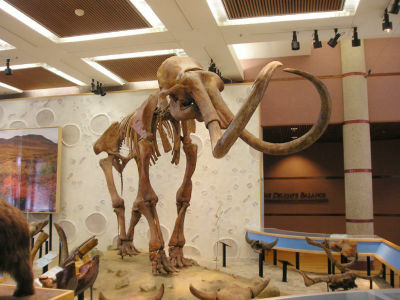How did people store food in an era when there was no refrigerator?

Refrigerators that can store food at low temperatures for a long time are indispensable items for modern people's lives. The history of refrigerators is relatively new,
How did ancient people store food before refrigeration? | Live Science
https://www.livescience.com/ancient-food-storage
In 2015, mammoth bones were discovered on farmland in Michigan, USA.

Investigation of this fossil revealed that mammoths inhabited the North American continent 11,700 years ago. In addition, the mammoth corpse was left unattended after natural death due to 'there were dents and incisions left in the bone,' 'stone tools were excavated at the same time as the bone,' and 'large rocks were mixed in the bone.' It was suggested that it was not the one that was used, but that the hunter-gatherers had sunk it in the pond and kept it.
Submerging meat in water is likely to cause it to rot, but Professor Daniel Fischer of the University of Michigan Paleobiological Museum said that
Lactobacillus bacteria are a type of lactic acid bacteria that convert sugar into lactic acid, and because they attach to meat and produce lactic acid, it is possible to prevent meat from spoiling. In addition, Professor Fisher argued that not only the bacteria of the genus Lactobacillus but also the low water temperature of the pond where the meat was submerged and the low oxygen content of the pond water may have been suitable for meat preservation. Did.
To confirm his theory, Professor Fisher conducted an experiment in which dismantled horses and deer were submerged in a pond, pulled up every two weeks, and the meat was cut off to verify whether they could actually be eaten. As a result, it was confirmed that if the meat is cooked for sterilization, the meat that has been submerged in the pond for half a year can be eaten without any problem. In addition, when summer approaches for more than half a year, it seems that spoilage has begun and the meat has a tingling taste.
Professor Fischer, who actually ate the meat preserved in the same way as it was over 10,000 years ago, said, 'Maybe the mammoths were hunted in the fall. The mammoths were dismantled on the spot and sunk in a small pond nearby. The meat can be eaten until the summer of the following year, and the lactic acid softens the meat. It also has a strong cheese-like aroma and taste, making it a very interesting meal. ' ..
In addition, in the Northern Europe that had been saved and put to swamp the food, including butter turns out we are. In 2019, a research team led by Assistant Professor Jessica Smith of the Department of Archeology at University College Dublin unearthed a waxy wax-like substance from mud collected from swamps in Ireland and Scotland. Analysis of the substance revealed that it was a dairy product rather than a wax.
The following are the dairy products that were actually excavated. The columnar one on the upper left is the oldest and is thought to date from 360 to 200 BC. The research team calls dairy products excavated from the swamp 'bog butter.'

According to Assistant Professor Smith, the preservation method of 'submerging in a swamp to store butter' is also mentioned in 17th century books. 'The act of submerging butter in a swamp is often considered anomalous, but it is probably a common preservation method in the past,' said Assistant Professor Smith. The butter submerged in the swamp seems to have a spicy flavor due to the influence of peat.
Related Posts:







